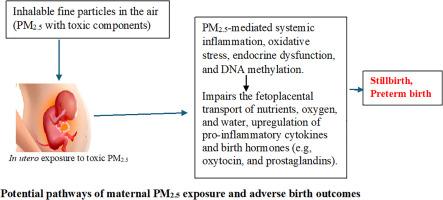Critical periods of maternal exposure to ambient fine particulate matter and the risks of stillbirth and spontaneous preterm birth in Western Australia
IF 7.1
1区 工程技术
Q1 CONSTRUCTION & BUILDING TECHNOLOGY
引用次数: 0
Abstract
Few studies have investigated weekly or monthly exposure-lag-response association between fine particulate matter (PM2.5) and preterm birth, and there has been no known such study for stillbirth. We aimed to identify potential critical susceptible periods of the association between monthly PM2.5 exposure during pregnancy and stillbirth and spontaneous preterm birth (sPTB). A total of 414,771 singleton births, of which 0.5 % and 3.9 % were stillbirth and sPTB respectively, between 1st January 2000 and 31st December 2015 in Western Australia were linked to fine spatiotemporal monthly PM2.5 concentrations. Monthly distributed lag linear and non-linear (DLM and DLNM) Cox regressions were performed to investigate PM2.5 exposure during pregnancy and covariate-adjusted hazards of stillbirth and sPTB. The mean PM2.5 exposure during pregnancy was 8.1 μg/m3. Pregnancy PM2.5 exposure showed small dose-response associations with stillbirth and sPTB with critical susceptible periods spanning the 3rd–6th gestational months, especially from the DLNM method. Relative to 5 μg/m3 from the DLM method, the strongest hazards of PM2.5 exposure were 1.04 (95 % CI 0.99, 1.08) and 1.03 (95 % CI 1.02, 1.05) during the 4th gestational month for stillbirth and sPTB, respectively. Monthly exposures at late pregnancy were associated with lower hazards. The average pregnancy exposure hazards were 1.08 (95 % CI 0.88, 1.32) and 1.07 (95 % CI 0.99, 1.15) per 5 μg/m3 increment for stillbirth and sPTB, respectively. The average entire pregnancy exposure showed potential attributable burden, synergistic interaction effects with biothermal stress, and comparatively higher hazards for female births and births to mothers who were Caucasian, < 35 years old, high SES, nulliparous, and smoked during pregnancy.

西澳大利亚州产妇暴露于环境细颗粒物的关键时期与死产和自然早产的风险
很少有研究对细颗粒物(PM2.5)与早产之间的每周或每月暴露滞后反应关系进行调查,也没有针对死产的已知研究。我们旨在确定孕期每月 PM2.5 暴露与死产和自发性早产(sPTB)之间关系的潜在关键易感期。2000年1月1日至2015年12月31日期间,西澳大利亚州共有414771名单胎婴儿出生,其中死胎和自发性早产分别占0.5%和3.9%。通过月分布滞后线性和非线性(DLM和DLNM)Cox回归,研究了怀孕期间的PM2.5暴露以及经协方差调整的死产和肺结核危害。孕期 PM2.5 平均暴露量为 8.1 μg/m3。妊娠期PM2.5暴露与死胎和肺结核的剂量-反应关系较小,临界易感期跨越第3-6个妊娠月,尤其是DLNM方法。相对于 DLM 方法中的 5 μg/m3 ,PM2.5 暴露对第 4 个妊娠月死产和多发性肺结核的最大危害分别为 1.04(95 % CI 0.99,1.08)和 1.03(95 % CI 1.02,1.05)。妊娠晚期的月度暴露与较低的危害相关。对于死胎和肺结核,平均孕期暴露危害分别为每 5 μg/m3 递增 1.08(95 % CI 0.88,1.32)和 1.07(95 % CI 0.99,1.15)。整个妊娠期的平均暴露量显示出潜在的可归因负担、与生物热应力的协同交互效应,以及对女婴和白种人、35 岁、高社会经济地位、无子宫和孕期吸烟母亲的危害相对较高。
本文章由计算机程序翻译,如有差异,请以英文原文为准。
求助全文
约1分钟内获得全文
求助全文
来源期刊

Building and Environment
工程技术-工程:环境
CiteScore
12.50
自引率
23.00%
发文量
1130
审稿时长
27 days
期刊介绍:
Building and Environment, an international journal, is dedicated to publishing original research papers, comprehensive review articles, editorials, and short communications in the fields of building science, urban physics, and human interaction with the indoor and outdoor built environment. The journal emphasizes innovative technologies and knowledge verified through measurement and analysis. It covers environmental performance across various spatial scales, from cities and communities to buildings and systems, fostering collaborative, multi-disciplinary research with broader significance.
 求助内容:
求助内容: 应助结果提醒方式:
应助结果提醒方式:


